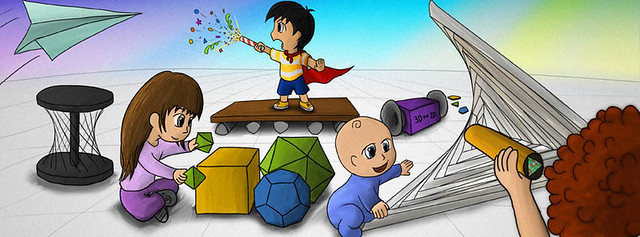Math Goggles #7 – It is News to Me
This week’s Math Goggles Challenge is inspired by Dr. Keith Devlin and his Introduction to Mathematical Thinking course on Coursera.org. By the way, if you are not sure what Math Goggles are and why wear them, here’s a good intro into the challenge.
Back to Dr. Devlin and this week’s challenge. In his very first lecture in the Intro to Math Thinking course, Dr. Devlin draws attention to the news headlines or, more specifically, to the rather common misuse of language in them. We, the readers, generally do not notice such misuse, unless it’s either a really glaring one or we are acting nitpicky. After all, we all know what the headline “Stolen Painting Found by Tree” means.
But in math precision is extremely important. Which explains, in large part, the time we took to craft definitions of the terms used in the Moebius Noodles book. Mathematicians have to be very literal. So this week, let’s look for ambiguous headlines. If you are pressed for time, you can always enter “ambiguous headlines” in the search bar of whatever Internet browser you use.
Otherwise, check out your daily paper or online news sites. Here are a few I spotted today:
- Teen Found after Ski Slope Disappearance
- Boyfriend Pushes Girlfriend off Cliff
- Chill Out: Researches engineer mice that can’t feel cold
Once you find the headlines, see if you can figure out a way to fix them to remove the unintended meaning. Don’t forget to share your finds with us.
Posted in Grow
Humanizing numbers
In a course I am leading for future teachers, one of the discussions was about comparing math, sciences and the humanities. I always encourage my students to read (and to write) Wikipedia. Lisa R. quoted the definition of the humanities from there, namely: “The humanities are academic disciplines that study the human condition, using methods that are primarily analytical, critical, or speculative” – and then she talked about humanizing numbers. What a neat idea!
The “analytical” part is common between math and the humanities. I realized that one of well-loved activities I do with young kids is all about adding critical and speculative elements to numbers.
I ask kids to draw numbers as characters, and to tell their stories. What color is each number? Do numbers have tails or wings? What clothes do they wear? Which ones are kind and which ones are mean? What are some numbers you personally like? What note would you play for each number on the piano?
Have you ever done activities like this with kids? Do you have favorite books or movies that do it? One of my favorite childhood stories, “The Magister of Absent-Minded Sciences,” in addition to humans, had several characters who happened to be numbers! Zero was young, proud and prone to be spectacularly wrong about the world. One was more meticulous – she would always rescue him and help him save face, too. Here’s how Zero looked:

Of course, you can do the same activity about any other object, like functions or equations.
Many mathematicians claim they hear melodies of equations, or see equations in color. The name for this effect is synesthesia.
Posted in Grow
Newsletter February 28, 2013

Welcome to adventurous math for the playground crowd! I am Moby Snoodles, and I love to hear from you at moby@moebiusnoodles.com
Book news
We are almost done copy editing. What’s with the “almost” part, you ask? Turns out, it takes a lot of work to craft definitions so they come out just right. And by “just right” we mean both rigorous and accessible. Should we be so particular when defining math terms for little kids? We believe so. In fact, based on our experience playing and talking with children, we know that they are very keen observers who will spot inconsistencies, notice exceptions, and call you up on contradictions. This, combined with their curiosity and fearlessness of complex math ideas makes our task both exciting and challenging.
Last week we went through about a dozen versions of the definition of recursion. The notion appears in chapters on functions and fractals. We ended up with a version from computer science rather than math. We believe it makes the most sense. Check it out:
What do “This Is the House That Jack Built,” slicing pizza, and stacking up blocks have in common? They are all examples of recursion: applying the same operation to previous results. This produces patterns that change in a self-similar ways, much like fractals. You put the next block on top of all past blocks; you repeat – and an amazing block tower grows till the baby knocks it down. You slice each piece of your pizza in half; you repeat – until there are enough slices for everyone. You keep on adding verses – while keeping the entire previous rhyme, much like the block tower:
This is the dog that worried the cat
That killed the rat that ate the malt
That lay in the house that Jack built.
Bold words are also defined in the glossary. We hope our glossary will be a start of a stand-alone resource. There is a general lack of simple rigorous math definitions! For example, Wikipedia has several relevant articles: Yon Yonson and House That Jack Built and Cumulative tale. But click math links in the articles at your own risk, because the definitions assume very formal math background!
Blogs and networks
Our weekly Math Goggles series has two new activities out!
In #6 Yelena invites you to read math stories:
March is a great month for math holidays. First Wednesday of the month is the World Maths Day. Right after it comes the World Science Day. Then, of course, there’s the Pi Day. But first, at least this year, comes the Read Across America Day. So this week’s Math Goggles challenge is to pick up and read a fun math book. If you are not sure what Math Goggles Challenges are all about, check here first. If you are not sure how a math book can be fun, read on.
In #5 you can ascend from cleanliness to mathyness:
I imagined creating an algorithm for a robot to wash my dishes. My algorithm started with the robot checking whether there were any dishes in the sink. If no, it’d stand by or, ideally, switch to a different chore. If yes, then it would turn water on. Then it would soap up the scrubby and pick up the first dirty plate. Scrub, rinse, check, put on a drying rack. Repeat until the sink is empty. Are those the smallest steps that my dish-washing algorithm can be broken into? Of course, not…
Malke, meanwhile, is thinking in threes. Check out the gorgeous Sierpinski fractal made out of clover! Could you use four-leaf clover instead? How?

Sharing
You are welcome to share the contents of this newsletter online or in print. You can also remix and tweak anything here as you wish, as long as you share your creations on the same terms. Please credit MoebiusNoodles.com
More formally, we distribute all Moebius Noodles content under the Creative Commons Attribution-NonCommercial-ShareAlike license: CC BY-NC-SA
Talk to you again on March 15th!
Moby Snoodles, aka Dr. Maria Droujkova
Posted in Newsletter
Math Goggles #6 – Let’s Read Math Story

March is a great month for math holidays. First Wednesday of the month is the World Maths Day. Right after it comes the World Science Day. Then, of course, there’s the Pi Day. But first, at least this year, comes the Read Across America Day. So this week’s Math Goggles challenge is to pick up and read a fun math book. If you are not sure what Math Goggles Challenges are all about, check here first. If you are not sure how a math book can be fun, read on.
Math books can be boring, but so can non-math books. But just like non-math books can be fascinating, interesting, intriguing, beautiful, witty, uproariously funny, thoughtful, and in general unputdownable, so can many math books. The key is to find the book that speaks to you. Check out the LivingMath.net’s huge reading list, ask a librarian, do an online search or see what comes up on Amazon when you type in “math book” or “book about math” or search for a particular math term in their Books section.
Don’t limit yourself in your search. Don’t limit just to what you already know! In fact, there are some terrific books to be found if you search for “don’t know about math”. Most importantly, do not restrict your search to books for grown-ups. Why should you? Some of our most favorite and beloved books are the children’s books.
So what are you waiting for? This week, find your own great math book, enjoy it, and share with us! I’ll be reading Theoni Pappas “Fractals, Googols and Other Mathematical Tales“. And what about you?
Posted in Grow





